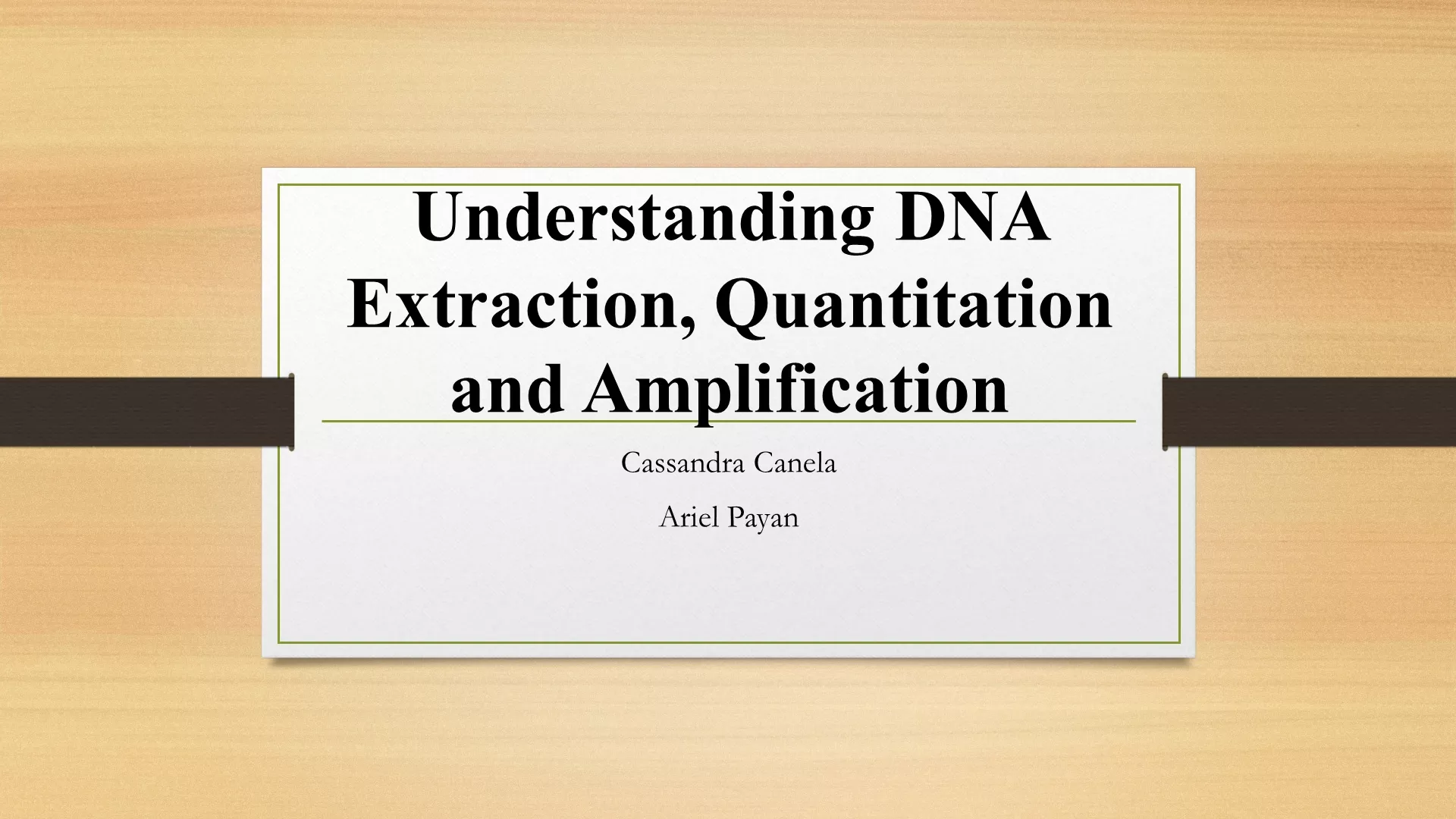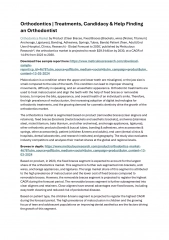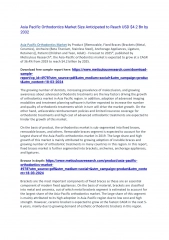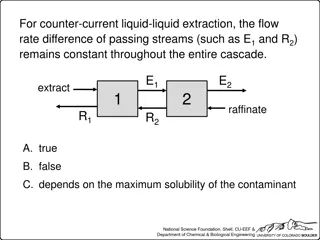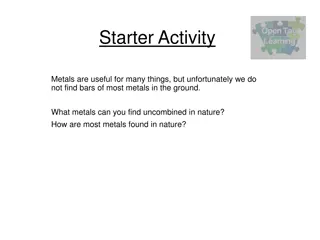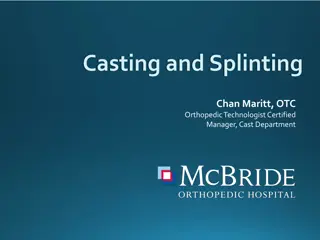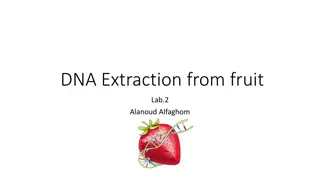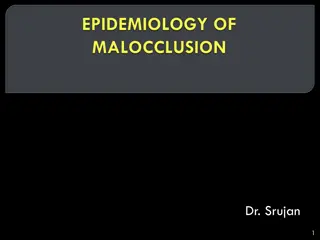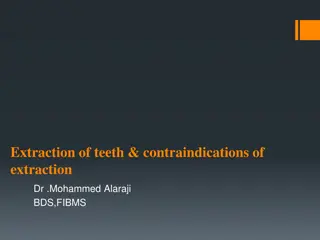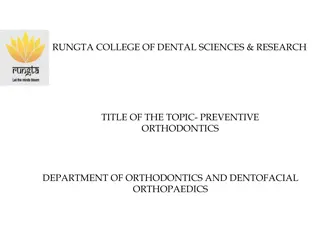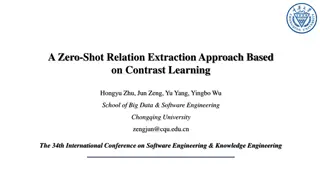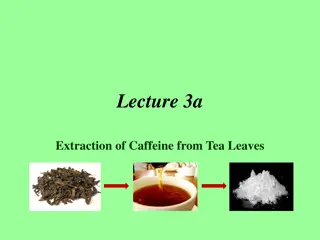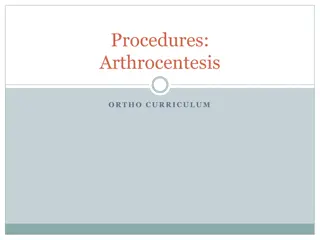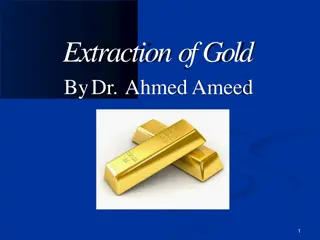Extraction in Orthodontics and Dentofacial Orthopedics: Comprehensive Overview
Painless extraction of teeth is crucial in orthodontic treatment for achieving normal occlusion and creating space in the dental arch. Historical background traces the evolution of extraction in orthodontics. The need for extraction is determined by factors like arch length-tooth material ratio, inter-arch relationships, tooth size abnormalities, and jaw malrelations. Understanding these aspects is vital in decision-making for extraction procedures.
Download Presentation

Please find below an Image/Link to download the presentation.
The content on the website is provided AS IS for your information and personal use only. It may not be sold, licensed, or shared on other websites without obtaining consent from the author.If you encounter any issues during the download, it is possible that the publisher has removed the file from their server.
You are allowed to download the files provided on this website for personal or commercial use, subject to the condition that they are used lawfully. All files are the property of their respective owners.
The content on the website is provided AS IS for your information and personal use only. It may not be sold, licensed, or shared on other websites without obtaining consent from the author.
E N D
Presentation Transcript
RUNGTA COLLEGE OF DENTAL SCIENCES & RESEARCH TITLE OF THE TOPIC- EXTRACTION DEPARTMENT OF ORTHODONTICS AND DENTOFACIAL ORTHOPAEDICS
Specific learning Objectives CORE AREAS DOMAIN CATEGORY INTRODUCTION AFFECTIVE DESIRE TO KNOW HISTORICAL BACKGROUND AFFECTIVE DESIRE TO KNOW NEED FOR EXTRACTION COGNITIVE MUST KNOW CHOICE OF TEETH FOR EXTRACTION PSYCHOMOTOR MUST KNOW DIFFERENT EXTRACTION PROCEDURES PSYCHOMOTOR NICE TO KNOW
CONTENTS INTRODUCTION HISTORICAL BACKGROUND NEED FOR EXTRACTION CHOICE OF TEETH FOR EXTRACTION DIFFERENT EXTRACTION PROCEDURES
Introduction Painless removal of teeth from its socket is termed as Extraction. It is one of the most common methods of gaining space in the arch. Establishment of normal functional occlusion in balance with supporting structures occasionally requires the reduction of one or more teeth. Most extraction are performed as part of a general plan of treatment that also involves the use of an appliance.
Historical Background As early as 1771, John Hunter recognized the role of extraction in orthodontics in his book Natural History of the Teeth. Although Extractions in orthodontics has remained a subject of speculation and contention. Angle taught that the basic foundation for the correction of malocclusion was the retention of the full complement of teeth. According to him, if crowded teeth were aligned in correct relation to each other, improved function of the masticatory apparatus would result in growth of the jaws, creating adequate space for the dentition. Therefore, he advocated expansion of arches in all orthodontic patients.
Need For Extraction There are a number of circumstances that necessitate extraction of teeth as a part of routine orthodontic treatment. They are listed as follows: Arch length-tooth material discrepancy Correction of sagittal inter-arch relationship Abnormal size and form of teeth Skeletal jaw malrelations
Arch Length-tooth Material Discrepancy Ideally the arch length and tooth material should be in harmony with each other . The presence of tooth material in excess of the arch length can result in crowding of teeth or proclination of anterior. It is not normally acceptable to increase the dental arch size, because the increased dental arch dimension would not be tolerated by the oral musculature. Hence reduction of tooth material is the only alternative. Extraction of one or more teeth is required in case of severe tooth material-arch length discrepancy.
Guidelines for extraction in class I crowding/ protrusion: Less than 4 mm arch length discrepancy extraction rarely indicated. 5-9 mm arch length discrepancy non-extraction or extraction possible; 10 mm or more arch length discrepancy extraction almost always required.
Correction of sagittal inter-arch relationship Sagittal malrelation such as class II or class III malocclusion may require extraction of teeth to achieve normal sagittal inter-arch relation. The extraction of teeth in such cases helps in establishing normal incisor and molar relationship. Extraction of teeth impairs the forward development of the dental arches and the alveolar process. Thus extraction of certain teeth in Angle s class II and class III malocclusion improves the sagittal relationship not only by tooth movement but also by selective forward growth impairment.
Angles class I: These patients are characterized by a normal sagittal inter-arch relation. Thus it is not advisable to discourage the development of one dental arch more than the other. Hence in Angle s class I cases, it is preferable to extract in both the arches.
Angles class II: In most class II cases, the upper dental arch is forwardly placed or the lower arch placed back. Thus by extracting only in the upper arch it is possible to reduce the abnormal upper proclination and also to discourage the forward development of the upper arch Angle s class III: It is beneficial to avoid extraction in the upper arch as it may affect the forward development of the maxilla . Angle s class III cases are preferably treated by extraction only in the lower arch or by extraction in both arches.
Abnormal size and form of teeth Teeth that are abnormal in size or form may necessitate their extraction in order to achieve satisfactory occlusion. Such anomalies include macrodontia , severely hypoplastic teeth , dilaceration and abnormal crown morphology.
Skeletal jaw relation Severe skeletal malrelation of the jaw may not be satisfactorily treated using orthodontic appliance alone. Surgical resective procedures along with extraction may be required.
Extraction Of Upper Incisors The maxillary incisors are rarely extracted as a part of orthodontic therapy. There are certain condition when one or more of the upper incisors may have to be scarified. The following are some of them: An unfavourably impacted upper incisor that cannot be brought to normal alignment. A buccal / lingual blocked out lateral incisor with good contact between the central incisor and canine can be extracted
If one of the lateral incisors are congenitally missing, the opposite lateral may have to be extracted in order to maintain arch symmetry. A grossly carious incisors that cannot be restored may have to be sacrificed. Malformation of incisors crown that cannot be restored by prosthesis may necessitate their extraction. Trauma or irreparable damage to incisors by fracture may indicate their removal. An incisor with dilacerated root cannot be efficiently moved by orthodontic therapy. It is hence preferable to extract them.
Extraction Of Lower Incisors It is often very tempting to extract a lower incisor to relieve crowding particularly when it is confined to the anterior segment but its extraction should be avoided as far as possible because it causes: a. Remaining anterior teeth to imbricate b. Although crowding may be relieved in the short term, forward movement of buccal teeth leaves incisor contacts and positions less than ideal c. Lower intercanine width (ICW) decreases resulting in a secondary reduction in the upper ICW with crowding in the upper labial segment d. Deep bite e. Retroclination of lower incisors
However, in a few well-defined cases, extraction of lower incisors may be appropriate: a. When one incisor is completely excluded from the arch and there are satisfactory approximal contacts between other incisors b. Poor prognosis as in case of trauma, caries, bone loss, etc. c. Severely malpositioned incisor. d. Lower canines are severely inclined distally and lower incisors are fanned it is very difficult to correct this condition by extractions further back e. In mild Class III incisor relation with an acceptable upper arch and lower incisor crowding, a lower incisor may be extracted to achieve normal overjet, overbite and to relieve crowding. f. Bolton s mandibular anterior excess > 4 mm. g. Extraction of one lower incisor can be consider in adults who have had previous loss of premolars in each quadrant and present with late lower labial segment crowding.
Contraindications for mandibular incisor extraction i. Deep bite cases with horizontal growth pattern. ii. All cases which require upper first premolar extraction while canines are in a Class I relationship. iii. Bimaxillary crowding cases with no tooth size discrepancy in the incisor area. iv. Cases having anterior discrepancy due to either small lower incisors or large upper incisors
Extraction Of Canines Canines are not frequently extracted as a part of orthodontic treatment. The extraction of canines is said to cause: Flattening of face, Altered facial balance and Change in facial expression. The loss of a canine makes canine guidance impossible and may compromise a good functional occlusal result. The approximal contact between the lateral incisor and first premolar is rarely satisfactory.
Indications Ectopically erupted or unfavourably impacted A canine that is completely out of the arch with reasonably good contact between the lateral incisor and first premolar is an indication for its extraction. Mandibular canine may be extracted when it is likely to be very difficult to align, e.g. when it is excluded from the arch and the apex is severely malpositioned or when it is unfavorably impacted. Maxillary canines develop far away from their final location and have a long path of eruption from their development site to their final position in the oral cavity.
Extraction Of 1st Premolars The first premolar are the most commonly extracted teeth as part of orthodontic treatment. The reason for their extraction is as follows; Their location in the arch is such that the space gained by their extraction can be utilized for correction both in the anterior as well as the posterior region. The contact that results between the canine and second premolar is satisfactory. The extraction of the first premolar leaves behind a posterior segment that offers adequate anchorage for the retraction of the six anterior teeth.
Indications 1. To relieve moderate to severe anterior crowding in both the arches. In lower arch crowding, where canines are mesially inclined, spontaneous improvement in incisor alignment will follow. 2. Correction of moderate to severe anterior proclination as in Class II div 1 or Class I bimaxillary protrusion 3. In high anchorage cases, first premolar takes precedence over second premolar as the teeth to be extracted
Timing of Extraction The first premolars should not be extracted until all premolars, permanent incisors and canines have erupted sufficiently for brackets to be placed on them, as mesial migration is greatly increased by extraction. The four first premolars should not be extracted more than three weeks before starting active treatment to avoid mesial migration of posterior teeth and therefore leaving insufficient space for retraction
Extraction Of 2ndPremolars To relieve mild crowding and proclination where anchorage loss is desirable. Whenever the second premolar are unfavourably impacted, it is preferred to extract them rather than the first premolars. In open bites, they are preferred over first premolars as deepening of bite is encouraged. If grossly decayed or deeply filled second premolars, Early loss of a deciduous molar may cause forward movement of the first permanent molar leaving in-adequate space for the second premolar. In such cases, the second bicuspid erupts completely out of the arch .such a tooth may be indicated for extraction.
Extraction Of 1st Molars The first molar are not commonly extracted in conjunction with orthodontic therapy. Extraction of the first permanent molars is avoided for the following reasons; The extraction of the first molar does not give adequate space in the incisor region . The extraction of the first molar results in deepening of the bite . The second premolar and molar may tip into the extraction space. Mastication may be affected.
Indications: Grossly decayed molar or heavily filled teeth. Molars that are extruded or with marked periodontal involvement. In open bites as their extraction encourages deepening of bite . Orthodontically retreated cases presenting with Angle class II malocclusion where the first premolars have already been extracted.
Rules for Guidance to the Best Time for Extraction: When crowding is absent or confined to the premolar segment and no space is needed for anterior alignment then first molar is removed before second molar erupts to allow it to move forward during eruption and take up the first molar position. Also lower first molar needs to be removed earlier than upper first molar because second molar moves forward less readily in the lower jaw. When space is required for alignment of anteriors, it is preferable to wait for second molar eruption before first molar extraction to avoid space closure by forward movement of second molar
Extraction Of 2nd Molars The extraction of second permanent molars although not common, is advocated for a number of reasons, as follows; To prevent third molars impaction: The removal of second molars has been advocated for the prevention of lower third molar impaction . The cases that benefit from such extraction are those where the third molars are upright or not tipped mesially more than 30 degree . Upper second molars extraction if carried out prior to the eruption of the third molars results in satisfactory third molar position.
To relieve impaction of second premolars: The premature loss of second deciduous molars is usually followed by forward drift of the first permanent molars leaving inadequate space for the second bicuspid to erupt. Open bite cases: The extraction of the second molars deepens the bite . Thus they can be considered in open bites cases.
To enable distalization of first molars: In cases where the first permanent molars are to be distalized , the extraction of second molars can benefit the procedure. Distal movement of maxillary first molars in cases of extraction of maxillary second molars occurs rapidly and efficiently , reducing treatment time and protrusion of anterior teeth, which is a common side effect when distalizing molars in cases without extractions.
Extraction Of 3rd Molars Extraction of third molars during orthodontic treatment does not yield space that can be used for decrowding or reduction of proclination. Third molars are extracted for other reasons as follows: Grossly impacted third molars that are unable to erupt into ideal position are usually extracted. The erupting third molars have been implicated to be the cause for late lower anterior crowding . Although this theory has not been confirmed it nevertheless may have some role in lower anterior crowding. Malformed third molars that interfere with normal occlusion.
Wilkinsons Extraction Wilkinson advocated extraction of all the four first permanent molars between the age of 8 -9 years. The basis for such extraction is the fact that the first permanent molars are highly susceptible to caries. Their extraction provides additional space for eruption of the third molars . Thus impaction of third molars can be avoided. In general, crowding of the arch is minimized. Thus the other teeth have a lower risk of caries
Wilkinsons extraction has a number of drawbacks. The following are some of them; The extraction of first molars offers limited space to relieve crowding . The second bicuspid and second molars rotate and may tip into the extraction space . The removal of the first molars deprives the orthodontist of adequate anchorage for any orthodontic appliance.
Balancing Extraction Balancing extractions may be defined as the removal of a tooth on the opposite side of the same arch (although not necessarily the antimere) in order to preserve symmetry. Removal of a tooth from one side of a dental arch results in a tendency for the rest of the teeth to move towards the extraction space . The teeth distal to the extraction space move into the space while the teeth mesial to the extraction space can also move distally into the space . Thus the midline of the arch may shift to the side of the extraction space.
Compensating Extraction Compensating extraction refers to extraction of teeth in opposite jaws. Compensating extraction are carried out to preserve the buccal occlusal relationship. In a class I relationship it is usually advisable to extract in both the arches to preserve the buccal occlusal relationship.
SUMMARY Painless removal of teeth from its socket is termed as Extraction. It is one of the most common methods of gaining space in the arch. In orthodontics, establishment of a normal functional occlusion in balance with supporting structures occasionally requires reduction of one or more teeth.
REFERENCES Textbook of Orthodontics Gurkeerat Singh, Jaypee Brothers; 2nd Edition Orthodontics The Art and Science, S.I Bhalajhi, AryaMedi Publishing; 7th Edition Textbook of Orthodontics Sridhar Premkumar, Elsevier; 1st Edition Orthodontics: Diagnosis and Management of Malocclusion and Dentofacial Deformities O.P Kharbanda, Elsevier; 1st Edition


